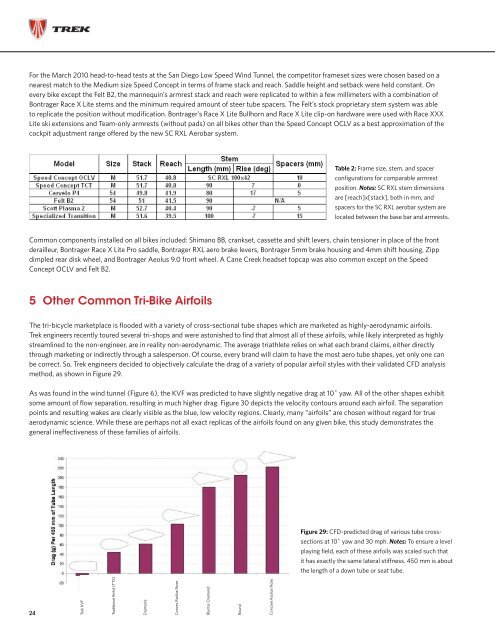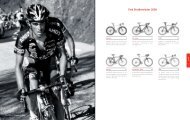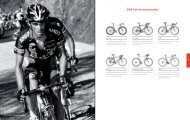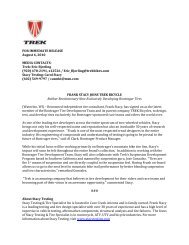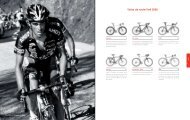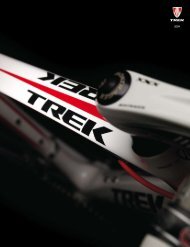Airfoil Development for the Trek Speed Concept ... - Slowtwitch.com
Airfoil Development for the Trek Speed Concept ... - Slowtwitch.com
Airfoil Development for the Trek Speed Concept ... - Slowtwitch.com
You also want an ePaper? Increase the reach of your titles
YUMPU automatically turns print PDFs into web optimized ePapers that Google loves.
For <strong>the</strong> March 2010 head-to-head tests at <strong>the</strong> San Diego Low <strong>Speed</strong> Wind Tunnel, <strong>the</strong> <strong>com</strong>petitor frameset sizes were chosen based on a<br />
nearest match to <strong>the</strong> Medium size <strong>Speed</strong> <strong>Concept</strong> in terms of frame stack and reach. Saddle height and setback were held constant. On<br />
every bike except <strong>the</strong> Felt B2, <strong>the</strong> mannequin’s armrest stack and reach were replicated to within a few millimeters with a <strong>com</strong>bination of<br />
Bontrager Race X Lite stems and <strong>the</strong> minimum required amount of steer tube spacers. The Felt’s stock proprietary stem system was able<br />
to replicate <strong>the</strong> position without modification. Bontrager’s Race X Lite Bullhorn and Race X Lite clip-on hardware were used with Race XXX<br />
Lite ski extensions and Team-only armrests (without pads) on all bikes o<strong>the</strong>r than <strong>the</strong> <strong>Speed</strong> <strong>Concept</strong> OCLV as a best approximation of <strong>the</strong><br />
cockpit adjustment range offered by <strong>the</strong> new SC RXL Aerobar system.<br />
!<br />
Table 2: Frame size, stem, and spacer<br />
configurations <strong>for</strong> <strong>com</strong>parable armrest<br />
position. Notes: SC RXL stem dimensions<br />
are [reach]x[stack], both in mm, and<br />
spacers <strong>for</strong> <strong>the</strong> SC RXL aerobar system are<br />
located between <strong>the</strong> base bar and armrests.<br />
Common <strong>com</strong>ponents installed on all bikes included: Shimano BB, crankset, cassette and shift levers, chain tensioner in place of <strong>the</strong> front<br />
derailleur, Bontrager Race X Lite Pro saddle, Bontrager RXL aero brake levers, Bontrager 5mm brake housing and 4mm shift housing, Zipp<br />
dimpled rear disk wheel, and Bontrager Aeolus 9.0 front wheel. A Cane Creek headset topcap was also <strong>com</strong>mon except on <strong>the</strong> <strong>Speed</strong><br />
<strong>Concept</strong> OCLV and Felt B2.<br />
5 O<strong>the</strong>r Common Tri-Bike <strong>Airfoil</strong>s<br />
The tri-bicycle marketplace is flooded with a variety of cross-sectional tube shapes which are marketed as highly-aerodynamic airfoils.<br />
<strong>Trek</strong> engineers recently toured several tri-shops and were astonished to find that almost all of <strong>the</strong>se airfoils, while likely interpreted as highly<br />
streamlined to <strong>the</strong> non-engineer, are in reality non-aerodynamic. The average triathlete relies on what each brand claims, ei<strong>the</strong>r directly<br />
through marketing or indirectly through a salesperson. Of course, every brand will claim to have <strong>the</strong> most aero tube shapes, yet only one can<br />
be correct. So, <strong>Trek</strong> engineers decided to objectively calculate <strong>the</strong> drag of a variety of popular airfoil styles with <strong>the</strong>ir validated CFD analysis<br />
method, as shown in Figure 29.<br />
As was found in <strong>the</strong> wind tunnel (Figure 6), <strong>the</strong> KVF was predicted to have slightly negative drag at 10˚ yaw. All of <strong>the</strong> o<strong>the</strong>r shapes exhibit<br />
some amount of flow separation, resulting in much higher drag. Figure 30 depicts <strong>the</strong> velocity contours around each airfoil. The separation<br />
points and resulting wakes are clearly visible as <strong>the</strong> blue, low velocity regions. Clearly, many “airfoils” are chosen without regard <strong>for</strong> true<br />
aerodynamic science. While <strong>the</strong>se are perhaps not all exact replicas of <strong>the</strong> airfoils found on any given bike, this study demonstrates <strong>the</strong><br />
general ineffectiveness of <strong>the</strong>se families of airfoils.<br />
Figure 29: CFD-predicted drag of various tube crosssections<br />
at 10˚ yaw and 30 mph. Notes: To ensure a level<br />
playing field, each of <strong>the</strong>se airfoils was scaled such that<br />
it has exactly <strong>the</strong> same lateral stiffness. 450 mm is about<br />
<strong>the</strong> length of a down tube or seat tube.<br />
24<br />
<strong>Trek</strong> KVF<br />
Traditional <strong>Airfoil</strong> (TTX)<br />
Diamond<br />
Convex Radius Nose<br />
Blunter Diamond<br />
Round<br />
Concave Radius Nose


